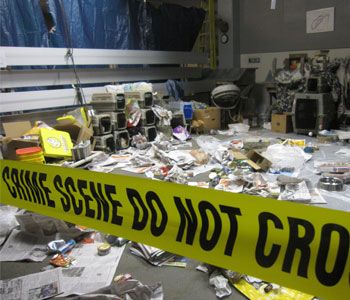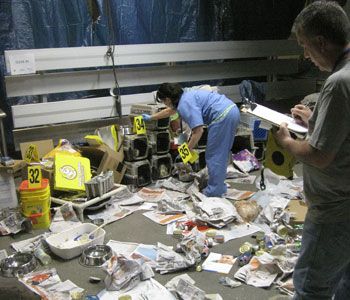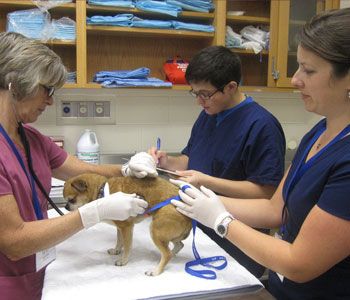Hoarding: Veterinarians investigate mock crime scene at conference
Program offers hands-on forensics training for veterinarians and students at University of Florida event.
Next >

Words of warning: Maddie’s Veterinary Forensics Conference included a series of wet lab experiences that featured mock animal hoarding crime scenes.
Gainesville, Fla. — Real cat skeletons were hidden amongst the debris and animal feces that covered the floor at the third annual Maddie’s Veterinary Forensics Conference, held in association with the American Society for the Prevention of Cruelty to Animals (ASPCA) at the University of Florida College of Veterinary Medicine on March 24-25.
A total of 160 veterinarians, veterinary students, animal shelter managers and criminal investigators attended the two-day conference dedicated to investigating animal hoarding situations. The conference included a series of wet lab experiences that featured mock animal hoarding crime scenes. Attendees were divided into small groups and rotated through three stations to learn the different stages of a typical hoarding investigation.
“It isn’t a normal part of veterinary training and yet when these hoarding cases happen in communities, veterinarians are almost always called to examine the animals or perform necropsies,” says Julie Levy, DVM, PhD, director of Maddie’s Shelter Medicine Program, a part of the veterinary college that focuses on shelter outreach and veterinary student education. “Without any formal training, it’s hard for veterinarians to know how to approach each hoarding situation.”
Photos courtesy of Rachel Michaud, program coordinator of Maddie’s Shelter Medicine Program
Click the Next button to go to the next page.

Mining through the mess: In the first stage of the investigation, attendees photographed, measured and documented evidence in each crime scene.
Hundreds of stuffed animals played the role of the feline and canine victims in eight different crime scenes. Levy and her staff even scattered soiled cat litter across each “movie set” to recreate the odor, while old pet crates, newspapers, pizza boxes and pop cans also set the scene.
“I’m so proud of my staff. They actually went dumpster-diving and found an old couch and hauled it back to the college,” Levy says. “Minus the animal suffering, everything else was very realistic.”
In the first stage of the investigation, attendees photographed, measured and documented evidence in a mock hoarding scene. “Forensic experts taught us how to process the crime scene and then they put us to work,” says attendee Patti Gordon, DVM, owner of All Cats HealthCare Clinic in Gainesville, Fla. “The experience made me realize how much I didn’t know—I didn’t learn any of this in veterinary school.”
After two hours of documenting, attendees presented their findings to instructors who gave feedback and pointed out evidence they’d overlooked. Then they moved on to stage two: the medical examination of live animals. Students and staff volunteered their pets as models and placed stickers all over the dogs’ bodies to represent lesions, wounds and other severe skin conditions typically found on hoarding victims. The veterinarians learned how to photograph and record these wounds.
Click the Next button to go to the next page.

Hoarding knowledge: After two hours of documenting, attendees presented their findings to instructors who gave feedback and pointed out evidence they’d overlooked.
“When animals are seized from a hoarding case, veterinarians log each pet and the animals are evaluated in a very systematic way,” Levy says. “The animals are important evidence too—especially when it comes to cruelty charges.”
During stage three of the investigation, attendees evaluated deceased animal victims. In large hoarding cases it’s common to find dead animals among the living, Levy says. She and her staff planted evidence in real dog and cat cadavers and veterinarians had to search for clues on the animals that would suggest neglect. They also were instructed to look for microchips to properly identify the animal.
“You can watch a presentation or read a book about hoarding, but it’s very different than facing the situation in real life,” Levy says. “Veterinarians have to be meticulous and patient in their examinations in order to get good documentation and have a good legal outcome in court.”
Click the Next button to go to the next page.

Evaluating evidence: During stage two of the investigation, veterinarians learned how to photograph and record these animal wounds.
She says veterinarians are often called to testify in court and if they’re not confident in their investigation skills, it can be a frightening experience. “Veterinarians play a critical role in the case because we are the animal experts,” Levy says. “This was a good experience to teach these skills in a context where the outcome isn’t so critical.”
The conference made attendee Katie Flood, DVM, of Animal Emergency and Referral Center in Fort Pierce, Fla., wonder if some of her patients in the past were victims of hoarding. Common signs to look for, she says, are really bad teeth, lesions across the body, terrible upper respiratory conditions, thin body condition, ringworm and poor socialization. Flood says veterinarians should also be concerned if clients bring a different pet to the clinic every time or notice a particularly bad odor. Some hoarders will seek veterinary care only when the cat or dog is in critical condition.
“Pet hoarding is more common than we’d like to believe,” Flood says. “It’s our job to be our patients’ advocates, not just with pet owners but with the authorities as well. A lot of veterinarians are hesitant to report clients, but we are the key to earlier interventions.”
Click the Next button to go to the next page.

Hoarding heroes: Staff volunteered their pets as models and placed stickers all over the dogs’ bodies to represent lesions, wounds and other severe skin conditions.
Levy often hears people try to explain away hoarding behavior with comments like, “It’s not the hoarders’ fault. Their heart is too big. They just love animals too much.”
However, the motivation of the hoarder who’s causing the neglect and the suffering doesn’t matter, she says—it’s the outcome for the animals that matters. Whether a person is intentionally cruel or neglects animals out of ignorance or the inability to understand his or her condition is irrelevant—it’s still cruelty, she says.
“We’ve had three different hoarding cases over the past few years in Florida that involved more than 600 cats,” Levy says. “I find it frustrating that these situations keep getting repeated and hundreds of animals suffer and die needlessly.”
Hoarding is like an addiction; 100 percent of hoarders will repeat the behavior unless they’re monitored, Levy says, adding that if they don’t receive treatment, they’ll just move jurisdictions and start acquiring animals again. (Click here to study the signs and find out if your client is an animal hoarder.)
Click the Next button to go to the next page.

Protect patients: "Pet hoarding is more common than we’d like to believe,” says attendee Katie Flood, DVM. “It’s our job to be our patients’ advocates."
“It’s important for veterinarians to get involved and deal with these cases formally because the courts can require mental health care, counseling and supervision and put a restriction on the amount of animals they can own—if any,” Levy says.
Levy says if veterinarians don’t go through the court they won’t have the authority to monitor the client long-term.
“Veterinarians need to maintain an awareness that animal hoarding happens in every community,” Levy says. “You can have compassion for the hoarder but that doesn’t mean we shouldn’t intervene. The cruelty is real for these animals and they deserve to have a good quality of life.”
FDA approves oral drug for broad canine protection against parasites
October 7th 2024Elanco's lotilaner, moxidectin, praziquantel, and pyrantel chewable tablets (Credelio Quattro) provide a single monthly dose for protection against fleas, ticks, heartworms, roundworms, hookworms, and 3 species of tapeworm.
Read More